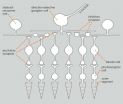(Press-News.org) FINDINGS: Whitehead Institute scientists have created a method that uses the enzyme sortase A to site-specifically modify proteins. Using this technique, researchers were able to increase potency, slow the metabolism, and improve thermal stability of several proteins, including interferon alpha 2 (IFN-alpha 2) and granulocyte colony-stimulating factor 3 (GCSF-3). IFN-alpha 2 is used to treat a variety of diseases, including leukemia, melanoma, and chronic hepatitis C, while GCSF-3 (known as filgrastim and marketed as Neupogen®) is administered to patients with neutropenia.
RELEVANCE: Sortase could be used to improve other proteins used as therapeutics, for example those with IFN-alpha 2's characteristic four-helix bundle structure. Such proteins include erythropoietin (EPO), interleukin (IL) 2 (known as aldesleukin and marketed as Proleukin®), IL-4, IL-7, IL9-, and IL-15. This same strategy could likely be applied to other therapeutically important proteins, but with a different folding pattern, as well.
Novel method could improve the performance of proteins used therapeutically
CAMBRIDGE, Mass. (March 9, 2011) – Whitehead Institute scientists have created a method that site-specifically modifies proteins to exert control over their properties when administered therapeutically. The technique should be useful to increase potency, slow metabolism, and improve thermal stability of therapeutically useful proteins, such as interferon alpha 2 (IFN-alpha 2), which is used to treat variety of diseases, including leukemia, melanoma, and chronic hepatitis C.
The method, reported this month in Proceedings of the National Academy of Sciences (PNAS), uses the enzyme sortase A and can be applied to tailor proteins that possess a structure found in IFN-alpha 2, referred to as a four-helix bundle. Such proteins include erythropoietin (EPO), granulocyte colony-stimulating factor 3 (GCSF-3, known as filgrastim and marketed as Neupogen®), interleukin (IL) 2 (known as aldesleukin and marketed as Proleukin®), IL-4, IL-7, IL9-, and IL-15.
"In the course of this work, the first author of the PNAS paper, Maximilian Popp, together with other members of the lab, has put together a nice palette of sortase-based techniques that now allow us to modify a large variety of different proteins, and equip them with properties and behaviors that cannot be easily specified by more standard molecular biological techniques," says Whitehead Member Hidde Ploegh. "I see the value of these approaches first and foremost in their general applicability and ease of use."
IFN-alpha 2 is a cytokine, a hormone-like substance that usually acts on cells other than those that produce the protein. Upon binding the cytokine, the recipient cell responds, for example by starting to divide and proliferate, or by exercising certain functions of benefit to the organism. Like other cytokines used for therapeutic purposes, IFN-alpha 2 can be a finicky drug. It is thermally unstable and must be continuously refrigerated to maintain its potency, a requirement that limits IFN-alpha 2's use in areas with intermittent or no electricity. Also, IFN-alpha 2's relatively short half-life (and resulting rapid clearance from the body) often necessitates frequent injections when the drug is used to treat certain conditions.
To keep therapeutic IFN-alpha 2 active in the body longer, the current strategy is to tack long polyethylene glycol (PEG) chains onto the protein to turn them into effective drugs. This so-called PEGylation not only masks IFN-alpha 2 from the patient's immune system but also increases the time the body needs to break it down. However, because current approaches to PEGylation are not specific, the PEG chains can block or alter the protein's normal binding site—an unintended consequence of this modification that can diminish IFN-alpha 2's potency by as much as 90%.
Seeking greater precision in attaching PEG chains, Popp, who is a graduate student in the Ploegh lab, used the enzyme sortase A to cleave IFN-alpha 2 at a specific site on the protein, engineered so that it would be recognized by the sortase. Then, a small molecule bearing the PEG chain was attached at the site cleaved by sortase. When Popp tested for biological activity, the resulting IFN-alpha 2 was highly potent, indicating that the PEG chains were not interfering with the drug's binding ability.
Popp also used sortase A to suture PEG chains to the cytokine GCSF-3. When he tested the PEGylated version in mice, it remained in the bloodstream significantly longer and evoked a more robust and prolonged response than a non-PEGylated version. By using sortase A's inherent precision to attach PEG chains, Popp could replace the less precise chemistry-based technique with a highly effective method that should have broader applications.
Next, Popp addressed IFN-alpha 2's thermal stability. Previously, the Ploegh lab stabilized linear polypeptides like IFN-alpha 2 by molecularly gluing their ends together to form circles. A few such cyclic proteins are found in nature. Once circularized, cyclic proteins are often more stable than their linear precursors. This forced looping can interfere with the function of some cell-signaling proteins, but because IFN-alpha 2's binding site is not near its ends, the function of IFN-alpha 2 is unaffected when its ends are joined to form a circle.
To create a cyclic version of IFN-alpha 2, Popp used sortase A to join the two ends of IFN-alpha 2. When he heated the cyclic form of IFN-alpha 2, it was more resistant to breakdown than its linear counterpart and remained biologically potent even after boiling. Popp then tested the circular, PEGylated version and the linear version in mice. The modified version was metabolized more slowly than the linear version and maintained its thermal stability, demonstrating that this simple technique can significantly enhance desirable properties of a therapeutically relevant protein without sacrificing its potency.
"We really take advantage of the site specificity of the sortase enzyme. Placing a molecular suture like that can't really be done by other means. So I think this method is of value to the protein engineering field in general," says Popp. "The reaction itself is easy, but it took some time to actually figure out how to do these transformations. Once we figured that out, the technique was robust and reproducible."
###
This research was supported by the National Institutes of Health (NIH).
Written by Nicole Giese
Hidde Ploegh's primary affiliation is with Whitehead Institute for Biomedical Research, where his laboratory is located and all his research is conducted. He is also a professor of biology at Massachusetts Institute of Technology.
Full Citation:
"Sortase-catalyzed transformations that improve the properties of cytokines"
PNAS, online February 9, 2011.
Maximilian W. Popp (1,2), Stephanie K. Dougan (1), Tzu-Ying Chuang (1), Eric Spooner (1), and Hidde L. Ploegh (1,2)
1. Whitehead Institute for Biomedical Research, 9 Cambridge Center, Cambridge, MA 02142
2. Department of Biology, Massachusetts Institute of Technology, 77 Massachusetts Avenue, Cambridge, MA 02142
Novel method could improve the performance of proteins used therapeutically
2011-03-10
ELSE PRESS RELEASES FROM THIS DATE:
First international index developed to predict suicidal behavior
2011-03-10
Although thousands of people commit suicide worldwide each year, researchers and doctors do not have any method for evaluating a person's likelihood of thinking about or trying to commit suicide. An international group of scientists, in which the Hospital del Mar Research Institute (IMIM) has participated, has devised the first risk index in order to prevent suicides.
"It is of key importance to identify suicidal thoughts among people at increased risk. The most important contribution that our study has made is an international risk index to estimate the likelihood of ...
More reasons to be nice: It's less work for everyone
2011-03-10
A polite act shows respect. But a new study of a common etiquette—holding a door for someone—suggests that courtesy may have a more practical, though unconscious, shared motivation: to reduce the work for those involved. The research, by Joseph P. Santamaria and David A. Rosenbaum of Pennsylvania State University, is the first to combine two fields of study ordinarily considered unrelated: altruism and motor control. It is to be published in a forthcoming issue of Psychological Science, a journal of the Association for Psychological Science.
"The way etiquette has been ...
Rutgers researchers identify materials that may deliver more 'bounce'
2011-03-10
NEW BRUNSWICK, N.J. – Rutgers researchers have identified a class of high-strength metal alloys that show potential to make springs, sensors and switches smaller and more responsive.
The alloys could be used in springier blood vessel stents, sensitive microphones, powerful loudspeakers, and components that boost the performance of medical imaging equipment, security systems and clean-burning gasoline and diesel engines.
While these nanostructured metal alloys are not new – they are used in turbine blades and other parts demanding strength under extreme conditions – ...
When leukemia returns, gene that mediates response to key drug often mutated
2011-03-10
(MEMPHIS, Tenn. – March 9, 2011) Despite dramatically improved survival rates for childhood acute lymphoblastic leukemia (ALL), relapse remains a leading cause of death from the disease. Work led by St. Jude Children's Research Hospital investigators identified mutations in a gene named CREBBP that may help the cancer resist steroid treatment and fuel ALL's return.
CREBBP plays an important role in normal blood cell development, helping to switch other genes on and off. In this study, researchers found that 18.3 percent of the 71 relapsed-ALL patients carried alterations ...
Gene variant influences chronic kidney disease risk
2011-03-10
A team of researchers from the United States and Europe has identified a single genetic mutation in the CUBN gene that is associated with albuminuria both with and without diabetes. Albuminuria is a condition caused by the leaking of the protein albumin into the urine, which is an indication of kidney disease.
The research team, known as the CKDGen Consortium, examined data from several genome-wide association studies to identify missense variant (I2984V) in the CUBN gene. The association between the CUBN variant and albuminuria was observed in 63,153 individuals with ...
New microscope decodes complex eye circuitry
2011-03-10
VIDEO:
Ganglion cells preferentially form synapses with those amacrine cells whose dendrites run in the direction opposite -- seen from the ganglion cell - to the preferred direction of motion (amacrine...
Click here for more information.
The sensory cells in the retina of the mammalian eye convert light stimuli into electrical signals and transmit them via downstream interneurons to the retinal ganglion cells which, in turn, forward them to the brain. The interneurons ...
Physicists measure current-induced torque in nonvolatile magnetic memory devices
2011-03-10
ITHACA, N.Y. - Tomorrow's nonvolatile memory devices – computer memory that can retain stored information even when not powered – will profoundly change electronics, and Cornell University researchers have discovered a new way of measuring and optimizing their performance.
Using a very fast oscilloscope, researchers led by Dan Ralph, the Horace White Professor of Physics, and Robert Buhrman, the J.E. Sweet Professor of Applied and Engineering Physics, have figured out how to quantify the strength of current-induced torques used to write information in memory devices ...
NASA and other satellites keeping busy with this week's severe weather
2011-03-10
Satellites have been busy this week covering severe weather across the U.S. Today, the GOES-13 satellite and NASA's Aqua satellite captured an image of the huge stretch of clouds associated with a huge and soggy cold front as it continues its slow march eastward. Earlier this week, NASA's Tropical Rainfall Measuring Mission satellite captured images of severe weather that generated tornadoes over Louisiana.
Today the eastern third of the U.S. is being buffered by a large storm that stretches from southeastern Minnesota east to Wisconsin and Michigan, then south through ...
International panel revises 'McDonald Criteria' for diagnosing multiple sclerosis
2011-03-10
International Panel Revises "McDonald Criteria" for Diagnosing MS -- Use of new data should speed diagnosis -- Publication coincides with MS Awareness Week
An international panel has revised and simplified the "McDonald Criteria" commonly used to diagnose multiple sclerosis, incorporating new data that should speed the diagnosis without compromising accuracy. The International Panel on Diagnosis of MS, organized and supported by the National MS Society and the European Committee for Treatment and Research in Multiple Sclerosis, was chaired by Chris H. Polman, MD, PhD ...
MIT scientists identify new H1N1 mutation that could allow virus to spread more easily
2011-03-10
CAMBRIDGE, Mass. -- In the fall of 1917, a new strain of influenza swirled around the globe. At first, it resembled a typical flu epidemic: Most deaths occurred among the elderly, while younger people recovered quickly. However, in the summer of 1918, a deadlier version of the same virus began spreading, with disastrous consequence. In total, the pandemic killed at least 50 million people — about 3 percent of the world's population at the time.
That two-wave pattern is typical of pandemic flu viruses, which is why many scientists worry that the 2009 H1N1 ("swine") flu ...



